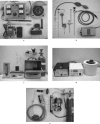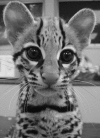Research in nondomestic species: experiences in reproductive physiology research for conservation of endangered felids
- PMID: 13130161
- PMCID: PMC7108633
- DOI: 10.1093/ilar.44.4.307
Research in nondomestic species: experiences in reproductive physiology research for conservation of endangered felids
Abstract
Tremendous strides have been made in recent years to broaden our understanding of reproductive processes in nondomestic felid species and further our capacity to use this basic knowledge to control and manipulate reproduction of endangered cats. Much of that progress has culminated from detailed scientific studies conducted in nontraditional laboratory settings, frequently at collaborating zoological parks but also under more primitive conditions, including in the field. A mobile laboratory approach is described, which incorporates a diverse array of disciplines and research techniques. This approach has been extremely useful, especially for conducting gamete characterization and function studies as well as reproductive surveys, and for facilitating the development of assisted reproductive technology. With continuing advances in assisted reproduction in rare felids, more procedures are being conducted primarily as service-related activities, targeted to increase effectiveness of species propagation and population management. It can be a challenge for both investigators and institutional animal care and use committees (IACUCs) to differentiate these service-based procedures from traditional research studies (that require IACUC oversight). For research with rare cat species, multi-institutional collaboration frequently is necessary to gain access to scientifically meaningful numbers of study subjects. Similarly, for service-based efforts, the ability to perform reproductive procedures across institutions under nonstandard laboratory conditions is critical to applying reproductive sciences for managing and preserving threatened cat populations. Reproductive sciences can most effectively assist population management programs (e.g., Species Survival Plans) in addressing conservation priorities if these research and service-related procedures can be conducted "on the road" at distant national and international locales. This mobile laboratory approach has applications beyond endangered species research, notably for other scientific fields (e.g., studies of hereditary disease in domestic cat models) in which bringing the laboratory to the subject is of value.
Figures



Similar articles
-
International training programs in reproductive sciences for conservation of Latin American felids.Anim Reprod Sci. 2004 Jul;82-83:21-34. doi: 10.1016/j.anireprosci.2004.05.008. Anim Reprod Sci. 2004. PMID: 15271441 Review.
-
The challenge of assisted reproduction for conservation of wild felids - A reality check.Theriogenology. 2023 Feb;197:133-138. doi: 10.1016/j.theriogenology.2022.11.018. Epub 2022 Nov 10. Theriogenology. 2023. PMID: 36502591
-
Monitoring and controlling ovarian activity in wild felids.Theriogenology. 2018 Mar 15;109:14-21. doi: 10.1016/j.theriogenology.2017.12.010. Epub 2017 Dec 11. Theriogenology. 2018. PMID: 29258698 Review.
-
Piecing together the puzzle of carnivore reproduction.Anim Reprod Sci. 2000 Jul 2;60-61:389-403. doi: 10.1016/s0378-4320(00)00084-1. Anim Reprod Sci. 2000. PMID: 10844210 Review.
-
Embryo technology in conservation efforts for endangered felids.Theriogenology. 2000 Jan 1;53(1):163-74. doi: 10.1016/s0093-691x(99)00249-6. Theriogenology. 2000. PMID: 10735071 Review.
Cited by
-
Factors Affecting Cryopreservation of Domestic Cat (Felis catus) Epididymal Spermatozoa.Animals (Basel). 2025 Mar 26;15(7):949. doi: 10.3390/ani15070949. Animals (Basel). 2025. PMID: 40218344 Free PMC article.
-
Assisted reproduction mediated resurrection of a feline model for Chediak-Higashi syndrome caused by a large duplication in LYST.Sci Rep. 2020 Jan 9;10(1):64. doi: 10.1038/s41598-019-56896-9. Sci Rep. 2020. PMID: 31919397 Free PMC article.
-
Evidence for compromised metabolic function and limited glucose uptake in spermatozoa from the teratospermic domestic cat (Felis catus) and cheetah (Acinonyx jubatus).Biol Reprod. 2010 Nov;83(5):833-41. doi: 10.1095/biolreprod.110.085639. Epub 2010 Jul 21. Biol Reprod. 2010. PMID: 20650882 Free PMC article.
-
Ovarian Stromal Cell-Conditioned Media, but Not Co-Culture, Improves Survival in Feline Follicles.Animals (Basel). 2025 May 24;15(11):1539. doi: 10.3390/ani15111539. Animals (Basel). 2025. PMID: 40509005 Free PMC article.
-
Effect of Cryodiluent and Time of Glycerol Addition on Cryopreservation and In Vitro Fertilization of Domestic Cat Epididymal Spermatozoa.Animals (Basel). 2025 Jun 6;15(12):1680. doi: 10.3390/ani15121680. Animals (Basel). 2025. PMID: 40564232 Free PMC article.
References
-
- Ballou JD. 1992. Potential contribution of cryopreserved germ plasm to the preservation of genetic diversity and conservation of endangered species in captivity. Cryobiology 29:19–25. - PubMed
-
- Ballou JD, Foose T. 1992. Demographic and genetic management of captive populations. In: Kleiman D, Lumpkin S, Allen M, Thompson K. eds. Wild Mammals in Captivity. Chicago: University of Chicago Press; p 263–283.
-
- Barone MA, Roelke ME, Howard JG, Brown JL, Anderson AE, Wildt DE. 1994. Reproductive characteristics of male Florida panthers: Comparative studies from Florida, Texas, Colorado, Latin America and North American zoos. J Mammal 75:150–162.
-
- CITES [Convention on International Trade of Endangered Species of Wild Fauna and Flora]. 2003. Appendices I, II, and III. CITES official website (www.cites.org), maintained by the CITES Secretariat.
-
- Donoghue AM, Johnston LA, Seal US, Armstrong DL, Simmons LG, Gross T, Tilson RL, Wolff P, Wildt DE. 1992. Ability of thawed tiger (Panthera tigris) spermatozoa to fertilize conspecific oocytes and bind and penetrate domestic cat eggs in vitro. J Reprod Fertil 96:555–564. - PubMed
Publication types
MeSH terms
LinkOut - more resources
Full Text Sources
Miscellaneous

